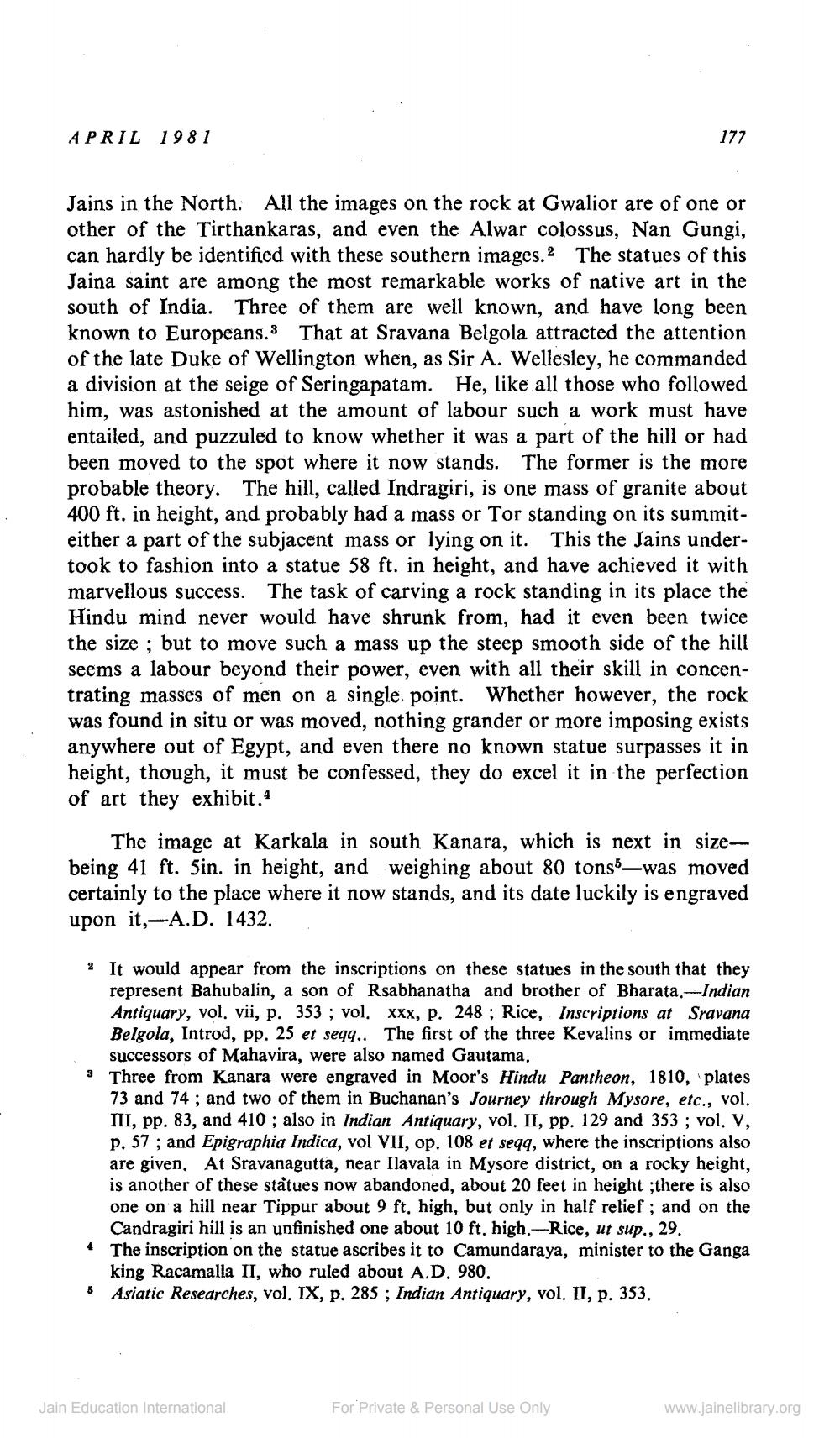________________
APRIL 1981
Jains in the North. All the images on the rock at Gwalior are of one or other of the Tirthankaras, and even the Alwar colossus, Nan Gungi, can hardly be identified with these southern images.2 The statues of this Jaina saint are among the most remarkable works of native art in the south of India. Three of them are well known, and have long been known to Europeans. That at Sravana Belgola attracted the attention of the late Duke of Wellington when, as Sir A. Wellesley, he commanded a division at the seige of Seringapatam. He, like all those who followed him, was astonished at the amount of labour such a work must have entailed, and puzzuled to know whether it was a part of the hill or had been moved to the spot where it now stands. The former is the more probable theory. The hill, called Indragiri, is one mass of granite about 400 ft. in height, and probably had a mass or Tor standing on its summiteither a part of the subjacent mass or lying on it. This the Jains undertook to fashion into a statue 58 ft. in height, and have achieved it with marvellous success. The task of carving a rock standing in its place the Hindu mind never would have shrunk from, had it even been twice the size; but to move such a mass up the steep smooth side of the hill seems a labour beyond their power, even with all their skill in concentrating masses of men on a single point. Whether however, the rock was found in situ or was moved, nothing grander or more imposing exists anywhere out of Egypt, and even there no known statue surpasses it in height, though, it must be confessed, they do excel it in the perfection of art they exhibit.4
177
The image at Karkala in south Kanara, which is next in sizebeing 41 ft. 5in. in height, and weighing about 80 tons-was moved certainly to the place where it now stands, and its date luckily is engraved upon it,-A.D. 1432.
2 It would appear from the inscriptions on these statues in the south that they represent Bahubalin, a son of Rsabhanatha and brother of Bharata.-Indian Antiquary, vol. vii, p. 353; vol. xxx, p. 248; Rice, Inscriptions at Sravana Belgola, Introd, pp. 25 et seqq.. The first of the three Kevalins or immediate successors of Mahavira, were also named Gautama.
3 Three from Kanara were engraved in Moor's Hindu Pantheon, 1810, plates 73 and 74; and two of them in Buchanan's Journey through Mysore, etc., vol. III, pp. 83, and 410; also in Indian Antiquary, vol. II, pp. 129 and 353; vol. V, p. 57; and Epigraphia Indica, vol VII, op. 108 et seqq, where the inscriptions also are given. At Sravanagutta, near Ilavala in Mysore district, on a rocky height, is another of these statues now abandoned, about 20 feet in height ;there is also one on a hill near Tippur about 9 ft, high, but only in half relief; and on the Candragiri hill is an unfinished one about 10 ft. high.-Rice, ut sup., 29.
4 The inscription on the statue ascribes it to Camundaraya, minister to the Ganga king Racamalla II, who ruled about A.D. 980.
5 Asiatic Researches, vol. IX, p. 285; Indian Antiquary, vol. II, p. 353.
Jain Education International
For Private & Personal Use Only
www.jainelibrary.org




